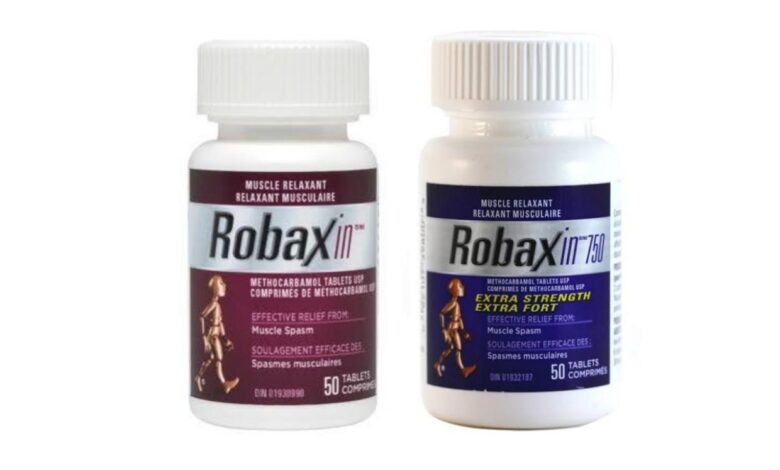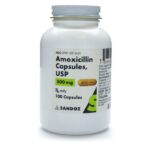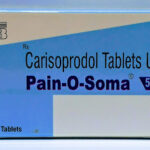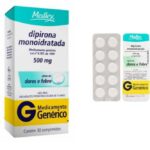Robaxin 500mg & 750mg: Uses, Dosage, Side Effects, Warnings

Robaxin is a brand of methocarbamol a medication used with rest, physical therapy, and other measures to relax muscles and relieve pain and discomfort caused by strains, sprains, and other muscle injuries. Methocarbamol is in a class of medications called muscle relaxants.
Muscle relaxants like Robaxin are prescribed for acute rather than chronic pain. They may be an option if the pain is preventing you from getting enough sleep. Because muscle relaxants cause drowsiness, they can help you get rest when you take them at night.
How Robaxin works
Robaxin belongs to a class of drugs called muscle relaxers. A class of drugs is a group of medications that work in a similar way. These drugs are often used to treat similar conditions. It’s thought that this drug decreases your body’s messages of pain and slows down your nervous system. This relaxes your muscles and provides pain relief.
How should Robaxin be taken?
The dosage of Robaxin depends on a variety of factors. The drug comes as a tablet to take by mouth. It usually is taken four times a day at first, then it may be changed to three to six times a day.
You should always follow your healthcare provider’s instructions when taking this medication.
Robaxin is available in 500 mg and 750 mg tablets. For adults with muscle stiffness, the typical dosage is 1,500 mg, four times daily. That’s three 500 mg tablets four times per day or two 750 mg tablets four times per day.
Research assessing the effects of methocarbamol among children under 16 years is limited. If your child has been prescribed Robaxin, follow the dosage instructions from your doctor.
Always take Robaxin exactly as directed. Do not take more or less of it or take it more often than prescribed by your doctor.
What happens if I miss a dose of Robaxin?
Take the medicine as soon as you can, but skip the missed dose if it is almost time for your next dose. Do not take two doses at one time.
What happens if I overdose on Robaxin?
Seek emergency medical attention or call the Poison Help line at 1-800-222-1222. Reports suggest overdose is more likely when Robaxin is used alongside alcohol or other sedative drugs.
Signs of overdose include:
- severe drowsiness
- severe dizziness
- loss of consciousness
- sweating
- difficulty breathing
- shaking on one side of the body
- seizures
What should I avoid while taking Robaxin?
Avoid driving or hazardous activity until you know how this medicine will affect you. Dizziness or drowsiness can cause falls, accidents, or severe injuries. Drinking alcohol with this medicine can cause side effects.
What are the side effects of Robaxin?
Robaxin oral tablets may cause drowsiness. It may also cause other side effects.
More common side effects
The more common side effects of Robaxin can include:
• headaches
• dizziness
• lightheadedness
• drowsiness
• sedation
If these effects are mild, they may go away within a few days or a couple of weeks. If they’re more severe or don’t go away, talk to your doctor or pharmacist.
Serious side effects
Call your doctor right away if you have serious side effects. Call 911 if your symptoms feel life-threatening or if you think you’re having a medical emergency. Serious side effects and their symptoms can include the following:
• Allergic reaction. Symptoms can include:
o rash
o itching
o hives
o swelling of your face, eyes, throat, and tongue
o chest tightness
o difficulty breathing
• Angioneurotic edema. Symptoms can include:
o swollen tissues
o pain in your abdomen
o swelling of your voice box
• Slowed heart rate
• Flushing
• Low blood pressure
• Injection site reactions. Symptoms can include:
o swelling of the vein at the injection site
o pain at the injection site
o peeling of skin at the injection site
o redness at the injection site
• Jaundice. Symptoms can include:
o yellowing of your skin and the whites of your eyes
• Low white blood cell counts
• Loss of memory
• Confusion
• Side effects that affect vision, including:
o double vision
o blurred vision
o uncontrolled eye movement
• Pink eye. Symptoms can include:
o red eyes
o watery eyes
o itchy eyes
• Lack of coordination
• Sleeplessness
• Seizures
• Vertigo
What drugs may interact with Robaxin?
Robaxin oral tablet can interact with other medications, vitamins, or herbs you may be taking. An interaction is when a substance changes the way a drug works. This can be harmful or prevent the drug from working well.
To help avoid interactions, your doctor should manage all of your medications carefully. Be sure to tell your doctor about all medications, vitamins, or herbs you’re taking. To find out how this drug might interact with something else you’re taking, talk to your doctor or pharmacist.
Interactions that can make drugs less effective
Taking Robaxin while you take pyridostigmine bromide can reduce the levels of pyridostigmine bromide in your body. This may reduce the effectiveness of pyridostigmine bromide.
Interactions that increase the risk of side effects
Taking Robaxin with certain drugs that also cause drowsiness raises your risk of this side effect. Examples of these drugs include:
- Anxiety drugs, such as lorazepam, diazepam, clonazepam, or alprazolam.
- Pain drugs, such as oxycodone, hydrocodone, tramadol, or morphine.
- Certain antidepressants, such as amitriptyline, doxepin, and imipramine.
- Antipsychotics, such as chlorpromazine, haloperidol, or quetiapine.
- Herbal products, such as kava-kava or valerian root.
Can Robaxin be used to treat opiate withdrawal?
Robaxin is considered a supplementary medication in the treatment of opioid or opiate withdrawal. It targets specific symptoms, such as muscle cramps and spasms.
It can be taken alongside Suboxone, a combination drug that’s effective in treating opioid addiction. Some research suggests that taking Robaxin or other ancillary medications doesn’t have an impact on treatment outcomes.
Also, although anecdotal reports exist, there isn’t any recent research investigating the effectiveness of using methocarbamol alone to treat opioid withdrawal.
Is Robaxin a narcotic?
No, Robaxin is not a narcotic and it isn’t addictive when used according to a doctor’s instructions. At higher doses, it has increased the potential for abuse, especially among people who have a history of narcotic abuse.
However, Robaxin doesn’t have the same properties as a narcotic:
- It doesn’t relieve generalized pain.
- It doesn’t produce a sense of euphoria or a “high.”
Higher doses also carry an increased risk of undesirable side effects, including drowsiness and dizziness. Given these characteristics, it has a relatively low potential for abuse.





